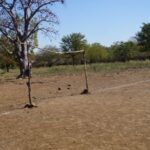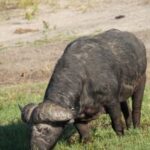Zim Zam Nam Bot, 4 countries, three days
May 14, 2019
I think I dressed appropriately today. My polo read “Grumpiest old man.” That’s because we had to wake up this morning at 5 am. My hat, however, is emblazoned, “Bring on the Adventure,” an old Canadian Scout motto I’ve made my own.
Fortunately, the latter dominated over the former, and it’s difficult to stay grumpy all day when you do the kinds of things I did.
We’ve spent the past few days in four different sub-Sahara countries. Zimbabwe is probably at one extreme, though we spent only a few hours on the Zimbabwe side of Victoria Falls. It’s probably Africa’s equivalent of Venezuela. The country just evicted a long-time dictator, who was so corrupt the Chinese cut off loans to the country. Rampant inflation has made the money denomination in the billions.
Namibia, where we spent two hours visiting a village without electricity (except as provided by generators and a big government compound set aside for the president and government workers with solar power), with 342 p
 eople, many of whom commute across the Chobe river to work in the lodges in Botswana (going through customs and immigration every day). We walked through a village of huts made from termite mud, reinforced with sticks, surrounded by fences made of reeds, and across a laid out soccer field with a goal post made, literally, with two y-shaped sticks with a cross branch marking the scoring parameters. Under a baobab tree reputedly close to a thousand years old, the local women were selling crafts, some of which were local baskets. Tellingly, they took dollars, euro, South African rand, but could not produce Namibian currency for one of our faculty members (named Money) who collects money. They told us when they take the currency across the river, they get charged 30% commission to exchange it—and almost everything they buy comes from the Botswana side. This strip along the river got tacked on to Namibia when it was German Southwest Africa, I think as a gesture from the British to give the Germans “coast line” without realizing the Zambezi/Chobe waterway was not navigable.
eople, many of whom commute across the Chobe river to work in the lodges in Botswana (going through customs and immigration every day). We walked through a village of huts made from termite mud, reinforced with sticks, surrounded by fences made of reeds, and across a laid out soccer field with a goal post made, literally, with two y-shaped sticks with a cross branch marking the scoring parameters. Under a baobab tree reputedly close to a thousand years old, the local women were selling crafts, some of which were local baskets. Tellingly, they took dollars, euro, South African rand, but could not produce Namibian currency for one of our faculty members (named Money) who collects money. They told us when they take the currency across the river, they get charged 30% commission to exchange it—and almost everything they buy comes from the Botswana side. This strip along the river got tacked on to Namibia when it was German Southwest Africa, I think as a gesture from the British to give the Germans “coast line” without realizing the Zambezi/Chobe waterway was not navigable.
Most interesting to me (besides the passport stamps) was that one of the concrete houses in the village belonged to a veteran of the Namibian war for independence. The country until around 1990 was a province of South Africa, and fought a bloody war (part of the Cold War, with China, Cuba, North Korea, Russia, and Angola supporting the rebel winners, and the United States and South Africa backing the eventual losers). The island is hundreds of miles from Windhoek, the capital, and has two cars on the island, both belonging to the government.
Botswana seems to be one of the few working democracies in sub-Sahara, at least historically. That’s partly because it has only 2 million people, a majority from the Swana tribe, and a government that has been relatively benevolent in spending money from diamond mines and some copper mines along the border area with the Democratic Republic of the Congo.
The country has also started to develop tourism, but rather than volume based, it has gone after the high-end tourist. That’s true of the resort where we’re at, whose gift shop and other prices, I’m told, are developed world standards. And that’s partly why we’re here—When I got a Southern  Africa Lonely Planet guide book, it suggested Chobe National Park is THE park, especially for elephants. Though the population of elephants has been declining (as we learned tonight in a talk from the director of Elephants without Borders), I have had 3 different types of safaris in the last 24 hours.
Africa Lonely Planet guide book, it suggested Chobe National Park is THE park, especially for elephants. Though the population of elephants has been declining (as we learned tonight in a talk from the director of Elephants without Borders), I have had 3 different types of safaris in the last 24 hours.
The first was a cruise last evening on the Chobe River, into the park. Late afternoons are a wonderful time to see wildlife along the river. The vegetarians all come down to the river, and not surprisingly, peace reigns (except for the impalas, who, like teen agers, wage combat for the babes). We saw crocodiles (they’re the major  carnivores we saw, happily previously fed), hippos, giraffes, and elephants. The morning ride (6 am-9) featured the elusive wild dogs (we learned later they had treed a leopard), which was really the highlight, along with just watching the sun come up. In the evening, Carolyn went on a jeep game drive, while I went back on the river for a photo cruise. I rented a camera with a 150-600 lens, with a guide who was a photographer, and a captain who knew how to position the boat for maximum effectiveness. About 400 photos later, sundown brought an end to the journey, and some relief; even though the camera was on a tripod, it was a challenge to point, decide on zoom length, etc. It got heavy. We saw and took pictures of a lot of birds, a monitor lizard (wonderfully camouflaged), and watched about 20 elephants lumber down to the river for a drink (it’s five o’clock somewhere), then douse themselves in dust. I can’t wait to see what the card pictures look like!
carnivores we saw, happily previously fed), hippos, giraffes, and elephants. The morning ride (6 am-9) featured the elusive wild dogs (we learned later they had treed a leopard), which was really the highlight, along with just watching the sun come up. In the evening, Carolyn went on a jeep game drive, while I went back on the river for a photo cruise. I rented a camera with a 150-600 lens, with a guide who was a photographer, and a captain who knew how to position the boat for maximum effectiveness. About 400 photos later, sundown brought an end to the journey, and some relief; even though the camera was on a tripod, it was a challenge to point, decide on zoom length, etc. It got heavy. We saw and took pictures of a lot of birds, a monitor lizard (wonderfully camouflaged), and watched about 20 elephants lumber down to the river for a drink (it’s five o’clock somewhere), then douse themselves in dust. I can’t wait to see what the card pictures look like!
When people ask me, “what’s your favorite country,” I always respond, truthfully, “where I’m at.” But I usually add, “There’s nothing quite like a safari.” The faculty on this trip, many of whom have never been on a safari before, would, I think, now agree.
I hope you get a chance to go on a real nature walk—it’s just like summer camp, except you see a lot more interesting animals!